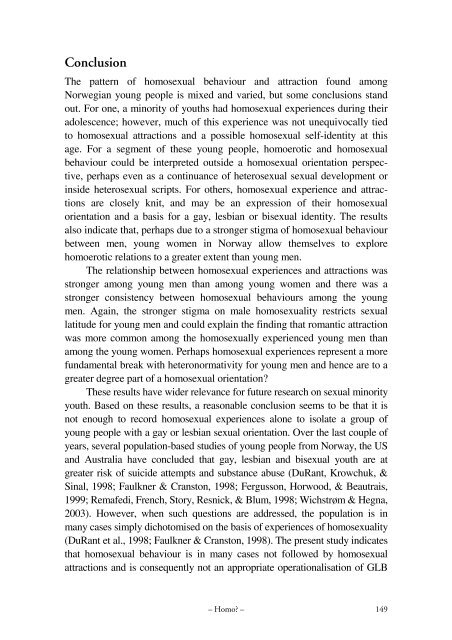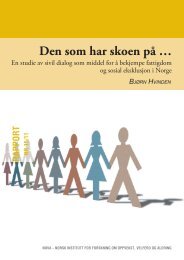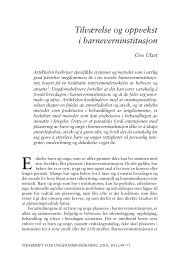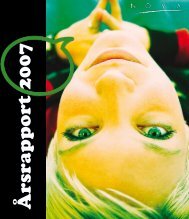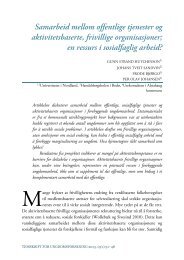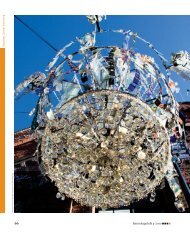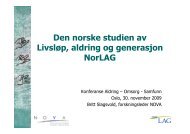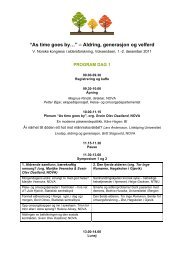Betydningen av seksuell erfaring, tiltrekning og identitet for ...
Betydningen av seksuell erfaring, tiltrekning og identitet for ...
Betydningen av seksuell erfaring, tiltrekning og identitet for ...
You also want an ePaper? Increase the reach of your titles
YUMPU automatically turns print PDFs into web optimized ePapers that Google loves.
Conclusion<br />
The pattern of homosexual beh<strong>av</strong>iour and attraction found among<br />
Norwegian young people is mixed and varied, but some conclusions stand<br />
out. For one, a minority of youths had homosexual experiences during their<br />
adolescence; however, much of this experience was not unequivocally tied<br />
to homosexual attractions and a possible homosexual self-identity at this<br />
age. For a segment of these young people, homoerotic and homosexual<br />
beh<strong>av</strong>iour could be interpreted outside a homosexual orientation perspective,<br />
perhaps even as a continuance of heterosexual sexual development or<br />
inside heterosexual scripts. For others, homosexual experience and attractions<br />
are closely knit, and may be an expression of their homosexual<br />
orientation and a basis <strong>for</strong> a gay, lesbian or bisexual identity. The results<br />
also indicate that, perhaps due to a stronger stigma of homosexual beh<strong>av</strong>iour<br />
between men, young women in Norway allow themselves to explore<br />
homoerotic relations to a greater extent than young men.<br />
The relationship between homosexual experiences and attractions was<br />
stronger among young men than among young women and there was a<br />
stronger consistency between homosexual beh<strong>av</strong>iours among the young<br />
men. Again, the stronger stigma on male homosexuality restricts sexual<br />
latitude <strong>for</strong> young men and could explain the finding that romantic attraction<br />
was more common among the homosexually experienced young men than<br />
among the young women. Perhaps homosexual experiences represent a more<br />
fundamental break with heteronormativity <strong>for</strong> young men and hence are to a<br />
greater degree part of a homosexual orientation?<br />
These results h<strong>av</strong>e wider relevance <strong>for</strong> future research on sexual minority<br />
youth. Based on these results, a reasonable conclusion seems to be that it is<br />
not enough to record homosexual experiences alone to isolate a group of<br />
young people with a gay or lesbian sexual orientation. Over the last couple of<br />
years, several population-based studies of young people from Norway, the US<br />
and Australia h<strong>av</strong>e concluded that gay, lesbian and bisexual youth are at<br />
greater risk of suicide attempts and substance abuse (DuRant, Krowchuk, &<br />
Sinal, 1998; Faulkner & Cranston, 1998; Fergusson, Horwood, & Beautrais,<br />
1999; Remafedi, French, Story, Resnick, & Blum, 1998; Wichstrøm & Hegna,<br />
2003). However, when such questions are addressed, the population is in<br />
many cases simply dichotomised on the basis of experiences of homosexuality<br />
(DuRant et al., 1998; Faulkner & Cranston, 1998). The present study indicates<br />
that homosexual beh<strong>av</strong>iour is in many cases not followed by homosexual<br />
attractions and is consequently not an appropriate operationalisation of GLB<br />
– Homo? – 149


